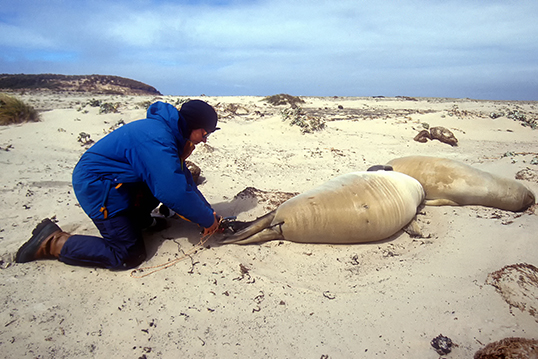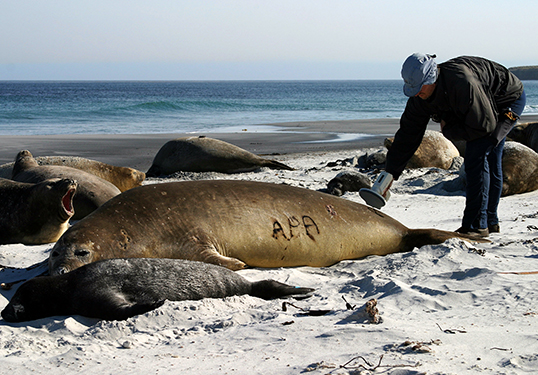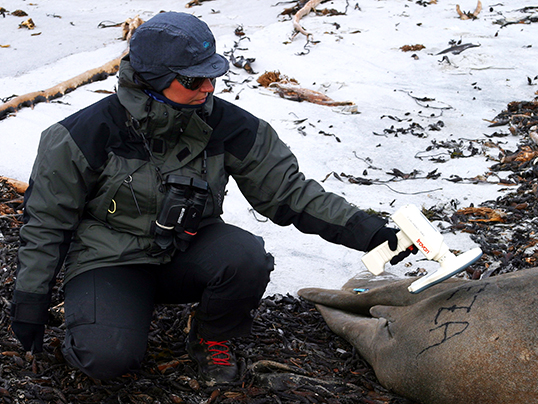Marking of seals
Tagging
Marking of individuals is the single most important activity during our field work. To be able to recognize individuals during each breeding season and across consecutive seasons we mark each animal appearing on the beach by cattle tags. Every breeding season we mark 97-99% of the breeding females, all the breeding males, all pups, and a large sample of subadult males. The tag is applied to the interdigital web of the hind flippers using a special applicator: tagging is not particularly painful, pain is localized and of short duration, and the vast majority of elephant seals are not upset by tagging.
Tagging of a weaned pup
An advantage of plastic tags is that they are cheap and may be applied to a large number of individuals in a short time by and experienced operator. Each tag carries on both sides a 3 or 4 digits code: the combination of color of the tag and number provides an effective identification system. By putting more than one tag on each individual is possible to be almost sure that an individual will be recognized when coming back the next season: in fact tag loss rate is low. For example, in 1997 and 1998 the likelihood to lose both tags, as calculated from a binomial model applied to double tagged individuals, was 0.0031 for both males and females.
Plastic tag, actual size (Jumbo Rototags -Dalton Supplies Ltd.)

A samples of the colours of the tags deployed on elephant seals at Sea Lion Island
Dye marking
To improve recognition of individuals from the distance and to be able to recognize seals whil observing their natural, undisturbed, behaviuour all breeding males and as much as possible breeding females are marked by names or codes painted on their flanks and back with black hair die. Good dye marks may last the whole breeding season, and often still readable when seals come back to land for the moult, but are lost during during the moulting process, that in elephant seals involves not only the fur but also the top layer of the skin.

Hair dye marking of an adult female (already marked on belly)

Hair dye marking of an adult male, Asco, a very friendly one
Passive transponders (PIT)
 To improve marking of weanlings, in 1997 we started a pilot test of an electronic identification system based on passive transponders: these are very small (about 11.5 mm long, diameter 2 mm) microchips that transmit a recognition code when stimulated from short distance by a reader. The transponder is implanted under the skin near the attack of the rear flippers using a syringe-like applicator: implantation requires a very short restrain effort by hands (without anaesthesia or instrumental restrain). Transponders are completely passive and operated without batteries: hence they have potentially a very long operating life. Moreover, they are implanted under the skin, with an almost null risk of loss: hence, they could be the definitive solution to the problem of long term marking of elephant seals pups.
In all, we put in place PITs on 510 weanlings (= 93.2 % of the full cohort of survivors of 1997). In 1998, we tested effectiveness of transponders in yearlings present on land during late November for the molt. In sample of 45 individuals, 42 transponders were easily read one or more time, and in consecutive days; on two of the remaining individuals, transponders were not read the first time because reading conditions were not optimal, but were read on next tries with the individual resting or sleeping; on just one individual we were not able to read the transponder in optimal reading conditions and after many tries. In all, failure rate was very low (97.8% of success).
To improve marking of weanlings, in 1997 we started a pilot test of an electronic identification system based on passive transponders: these are very small (about 11.5 mm long, diameter 2 mm) microchips that transmit a recognition code when stimulated from short distance by a reader. The transponder is implanted under the skin near the attack of the rear flippers using a syringe-like applicator: implantation requires a very short restrain effort by hands (without anaesthesia or instrumental restrain). Transponders are completely passive and operated without batteries: hence they have potentially a very long operating life. Moreover, they are implanted under the skin, with an almost null risk of loss: hence, they could be the definitive solution to the problem of long term marking of elephant seals pups.
In all, we put in place PITs on 510 weanlings (= 93.2 % of the full cohort of survivors of 1997). In 1998, we tested effectiveness of transponders in yearlings present on land during late November for the molt. In sample of 45 individuals, 42 transponders were easily read one or more time, and in consecutive days; on two of the remaining individuals, transponders were not read the first time because reading conditions were not optimal, but were read on next tries with the individual resting or sleeping; on just one individual we were not able to read the transponder in optimal reading conditions and after many tries. In all, failure rate was very low (97.8% of success).

Reading a transponder of an adult female with pup

